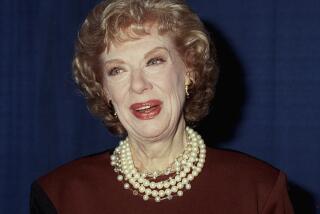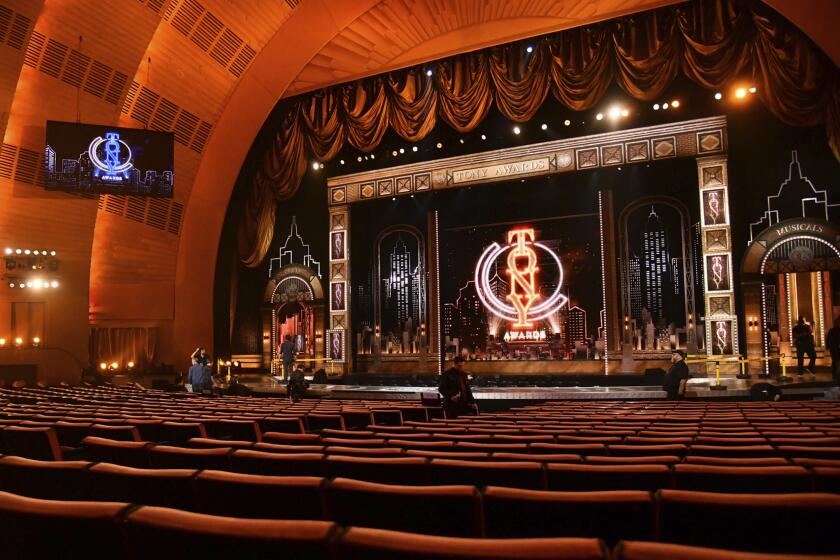A Complete Trip to the Moon
- Share via
Jackie Gleason was dubbed “The Great One” long before Wayne Gretzky picked up a hockey stick and earned that nickname, so it’s perhaps appropriate that TV Land will showcase “The Honeymooners” in a manner worthy of a king--or at least befitting a sitcom that helped gild TV’s Golden Age.
The nostalgic cable channel has restored roughly three minutes to each of the 39 episodes produced during the 1955-56 season that were excised for the broadcast of reruns in syndication. Those episodes will be shown this weekend as part of a 48-hour “Honeymooners” marathon.
Yet that’s just part of TV Land’s weeklong tribute, which commences tonight and also includes newly shot wraparounds featuring Art Carney in his role as Ed Norton; a special chronicling the show’s history; an hourlong musical episode, airing Wednesday, that hasn’t been televised since 1965; and a 1953 installment of the dramatic anthology “Studio One,” titled “The Laughmaker,” which paired Gleason and Carney.
“The Honeymooners,” featuring Gleason as cantankerous bus driver Ralph Kramden and Carney as his sewer-worker neighbor Ed Norton, premiered in 1951 as a segment of the DuMont Network’s “Cavalcade of Stars.” The concept then shifted to CBS as a regular sketch within “The Jackie Gleason Show” before becoming a stand-alone program, with Audrey Meadows as Ralph’s tart-tongued wife, Alice (Pert Kelton originated the role at DuMont and, in an odd twist, later appeared as Alice’s mother) and Joyce Randolph playing Norton’s wife, Trixie.
While “The Jackie Gleason Show” was initially a major hit--finishing No. 2 behind “I Love Lucy” in the 1954-55 prime-time standings--the stand-alone “Honeymooners” didn’t fare as well, hurt by “The Perry Como Show” on NBC. As a result, there was just one season of the half-hour format, although the segment resurfaced on Gleason’s variety show in 1960 and continued off and on until that program ended in 1971.
Despite its novel broadcast pattern, “The Honeymooners” has remained an icon, with Kramden the ultimate blue-collar Everyman, his foiled get-rich-quick schemes and tirades against Alice culminating on a reassuring note in the signature line, “Baby, you’re the greatest.”
The “classic 39” episodes have run almost nonstop over the decades, with an additional 52 “lost episodes” culled from the variety program cobbled together in 1985, two years before Gleason succumbed to cancer. After his death, The Times’ Howard Rosenberg called the show “just as funny today as 30 years ago, the situations still as relevant, the characters eternally fresh.”
Earle Marsh, who wrote the book “The Complete Directory to Prime Time Network and Cable TV Shows” with Tim Brooks, places the series behind only “I Love Lucy” in the pantheon of TV comedies, and then simply because of volume, not quality.
“Gleason did physical comedy because of his girth, but there was also some really good writing there,” Marsh noted. “It’s timeless, and that’s something that’s very hard for sitcoms. . . . Even something like ‘All in the Family,’ which is a classic, is very much of itsera.”
In fact, Marsh maintains the show served as an obvious template for a program that became even more successful: “The Flintstones.”
The “Inside TV Land” documentary illustrates both Gleason’s total control over the program and the challenge that posed to the cast and writers.
“It was a difficult show to do, because I didn’t like to rehearse,” Gleason admits in an interview clip. “We’d have one run-through in the afternoon before we did the show, and that was it.”
Gleason inspired awe and fear among those around him, and in a phone interview, Joyce Randolph--now 75 and living in New York--still refers to him as “Mr. Gleason.”
“It was scary,” she said of the production routine. “I saw an actor vomiting in the wings because he didn’t know he was going to go on live with one rehearsal.”
Already a larger-than-life figure, Gleason’s weight ballooned during the series, providing the basis for innumerable jokes at his expense. Many of the best lines went to Carney and Meadows. Yet, as writer Leonard Stern recalls in the special, when Gleason was informed he had relatively few jokes in an episode, “his reaction was always the same: ‘Do I have something to react to?’ ” Ralph’s riotous explosions at times left Gleason utterly exhausted at the show’s end.
A sister network to Nickelodeon available in nearly 47 million homes (just under half of all U.S. households), TV Land hopes to bring these programs both to those who grew up with them and new generations of viewers.
“Funny is something that works in any decade,” said TV Land general manager Larry Jones. “My 7-year-old loves it.”
Jones bought “The Honeymooners” kitchen set at an auction of memorabilia in June, putting it on tour as part of TV Land’s “ultimate fan search.” In hindsight, the $63,000 price may have been a bargain: Gleason’s bus driver outfit fetched $64,100.
Randolph can only marvel at the show’s enduring popularity. “We never knew this could happen,” she said. “We would have saved scripts if we knew they would be valuable.”
Although Carney won five Emmys for “The Honeymooners” and Meadows earned one, “The Great One” (a label said to have been ascribed to Gleason by Orson Welles) was passed over by TV academy voters, who didn’t warm to the imperious star. Gleason saw little reason for false humility, once saying, “Forty, 50 million people don’t get riveted by ‘humble.’ ”
The scope of TV Land’s tribute would no doubt have appealed to Gleason, who embraced his excesses--from his drinking to the lavish train trips he hosted from New York to Florida, with CBS picking up the tab.
“The train was a bar,” Gleason once told “60 Minutes.” “When you’ve got good ratings,there’s nothing they don’t provide.”
* TV Land will show “The Laughmaker” tonight at 7 and 10. “Inside TV Land: The Honeymooners” premieres Tuesday at the same times, with the “classic 39” marathon beginning Saturday at 3 a.m.
More to Read
The complete guide to home viewing
Get Screen Gab for everything about the TV shows and streaming movies everyone’s talking about.
You may occasionally receive promotional content from the Los Angeles Times.





